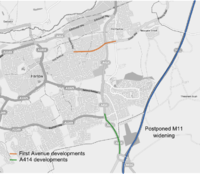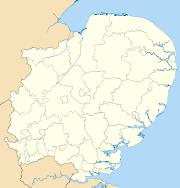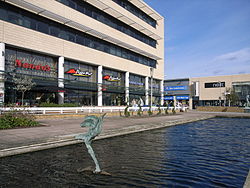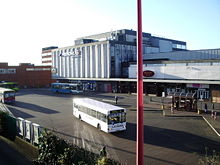- Harlow
-
For other uses, see Harlow (disambiguation).
Harlow Harlow Water Gardens, (The recently renovated part of the town centre)
Shown within EssexCountry United Kingdom Const Country England Region East of England Ceremonial County Essex Government - Leadership Alternative - Sec.31 - Control Conservative - MP Robert Halfon Area - District 11.8 sq mi (30.54 km2) Population - District Ranked 285th
81,700- Density 6,928.2/sq mi (2,675/km2) - Ethnicity[1] 92.5% White
2.5% Asian
1.8% Black
1.6% Chinese or Other
1.5% MixedONS code 22UJ Website http://www.harlow.gov.uk/ Harlow is a new town and local government district in Essex, England. It is located in the west of the county and on the border with Hertfordshire, on the Stort Valley, The town is near the M11 motorway and forms part of the London commuter belt.The district has a current population of 78,889 (2010 estimate).[2]
Contents
History
Etymology
There is some dispute as to where the placename Harlow derives from. One theory is that it derives from the Anglo-Saxon words 'here' and 'hlaw', meaning "army hill", probably to be identified with Mulberry Hill, which was used as the moot or meeting place for the district.
The other theory is that it derives from the words 'here' and 'hearg', meaning "temple hill/mound", probably to be identified with an Iron Age burial mound, later a Roman temple site on River Way.
The original village, mentioned in the Norman Domesday Book, developed as a typical rural community around what is now known as Old Harlow, with many of its buildings still standing.
Early history
The early / is Ancient History of Harlow as well as the Medieval history is considerable and substantial archaeological remains are extant both under the landscape and upon it. Alas most information is currently unpublished but some research at the Museum Of Harlow and discussions with the Archivist and Manager there should enable access to be granted to those curious enough to research it.
The earliest deposits are of a Mesolithic (circa 10,000 BC) hunting camp excavated by Davey in Northbrooks in the 1970s(Unpublished) closely followed by the large and unexcavated deposits of Neolithic flint located at Gilden Way. These deposits are mostly known of due to the large numbers of surface bound worked flint ; indeed there is substanital amounts to speculate on organised working of flint in the area. Large amounts of debetage litter the area and tools found include Axeheads, hammers, blades, dowles and other boring tools and multipuprpose flints such as scrapers. An organised Field Walk in the late 1990s by Bartlett(Unpublished)indicates that most of the area, some 80 hectares, produces worked flint from the Neolithic to the Bronze Age with a smattering of Mesolithic ; so basically it indicates organised industry from 5000 BC to 2000 BC. Indeed the deposits are so large and dispersed that any major archaeological work in the area will have to take this into consideration before any ground work is started.
The New Town
The new town was built after World War II to ease overcrowding in London at the same time as the similar orbital developments of Basildon, Stevenage, and Hemel Hempstead. The master plan for the new town was drawn up in 1947 by Sir Frederick Gibberd.[3][4] The development incorporated the market town of Harlow, now a neighbourhood known as Old Harlow, and the villages of Great Parndon, Latton, Tye Green, Potter Street, Churchgate Street, Little Parndon, and Netteswell. The town is divided into neighbourhoods, each self supporting with their own shopping precincts, community facilities and pub. Gibberd invited many of the country's leading post-war architects to design buildings in the town, including Philip Powell and Hidalgo Moya, Leonard Manasseh, Michael Neylan, E C P Monson, Gerard Goalen, Maxwell Fry, Jane Drew, Graham Dawbarn and William Crabtree. Harlow has one of the most extensive cycle track networks in the country, connecting all areas of the town to the town centre and industrial areas. The cycle network is composed mostly of the original pre-new town roads.
The town is notable being the location of Britain's first pedestrian precinct,[5] and first modern-style residential tower block, The Lawn,[6][7] constructed in 1951; it is now a Grade II listed building. Gibberd's tromp-l'oeil terrace in Orchard Croft and Dawbarn's maisonette blocks at Pennymead are also notable, as is Michael Neylan's pioneering development at Bishopsfield. The first neighbourhood, Mark Hall, is a conservation area. From 1894 to 1955, the Harlow parish formed part of the Epping Rural District of Essex.[8] From 1955 to 1974, Harlow was an urban district.[9]
The town centre, and many of its neighbourhood shopping facilities have undergone major redevelopment, along with many of the town's original buildings. Subsequently, many of the original town buildings, including most of its health centres, the Staple Tye shopping centre, and many industrial units have been rebuilt. GIbberd's original town hall, a landmark in the town, has been demolished and replaced by a new civic centre and shopping area.
Redevelopment
The town has already experienced expansion. The first of which was the "mini expansion" that was created by the building of the Sumners and Katherines estates in the mid to late seventies to the west of the existing town. Since then Harlow has further expanded with the Church Langley estate completed in 2005, and its newest neighbourhood Newhall nearing completion. The Harlow Gateway Scheme is currently underway, with the relocation of the Harlow Football Stadium to Barrow's Farm in early 2006, and the building of a new hotel, apartments, and a restaurant adjacent to the railway station being complete. The next stage of this scheme involves the completion of the 530 eco-homes being built on the former sports centre site, and the centre's relocation to the nearby former college playing field site.
Other major developments under consideration include both a northern and southern bypass of the town, and significant expansion to the north, following the completed expansion to the east. The Harlow North[10] plans, currently awaiting permission, involve an extension of the town across the floodplains on the town's northern border, into neighbouring Hertfordshire. The plan was supported by former MP Bill Rammell, all three political groups on Harlow Council, and the East of England Regional Assembly. It is opposed by Hertfordshire Council Council, East Herts Council, Mark Prisk, MP for Hertford, and Stortford in whose constituency the development would be and all the parishes concerned. The opposition is coordinated by a local group based in neighbouring East Hertfordshire.[11] An attempt to have Harlow North designated an "Eco Town" was rejected by the Minister for Housing, Caroline Flint, MP in April 2008
The south of the town centre also underwent major regeneration, with the new civic centre being built and the town's famous Water Gardens being redeveloped, a landscape listed by English Heritage. Their intended effect is somewhat spoiled by the abutment of a range of new shops, a major superstore, and several restaurants and cafés. It is likely that this development will be continued throughout the rest of the shopping district, with plans awaiting planning permission to be granted.
Economy
Harlow was originally expected to provide a majority of employment opportunities in manufacturing, with two major developments of The Pinnacles and Templefields providing the biggest employers in the region; as with the rest of the country, this manufacturing base has declined and Harlow has had to adjust.
The original manufacturing took the form of a biscuit factory, on the Pinnacles. Owned and run as a Co-Op, it provided employment to the town for over 50 years, before closing in 2002. It has since been demolished and the site is now small industrial units. At its peak, the factory employed over 500 people. At the time of its closure, the owner was Burton's Foods Ltd. An £8million production line – installed in 1999 – was left to rust in the car park upon the closure of the factory.
Raytheon and GlaxoSmithKline both have large premises within the town. Nortel also had a large site on the eastern edge of the town, acquired when STC was bought in 1991, and it was here that Charles K. Kao developed optical fibre data transmission. Nortel still has a presence, but it is much reduced. One of Europe's leading online golf stores, Onlinegolf, is also based in Harlow.
Unemployment is frequently around 10%, higher than the national average in the UK. Harlow also has a large number of people in social housing, almost 30%[2] of dwellings being housing association and local authority owned, and many more privately rented.
Politics
Labour MP Bill Rammell was reelected in the 2005 general election, with a majority of only 97 after considerable gains by the Conservative Party since the 1997 and 2001 elections but lost to Robert Halfon, Conservative, in the 2010 general election. Prior to the 2008 Council elections, no party had overall control of the local authority, which was run by a coalition of Liberal Democrats and Labour Party councillors. However, since the elections, the authority is under Conservative control.
Transport
Rail
Harlow is served by two railway stations, Harlow Town railway station and Harlow Mill railway station.
Road
Harlow is reached from junction 7 of the M11 motorway, which runs from London to Cambridge, placing it within a short distance of Stansted Airport and the A120 and the orbital M25 motorway. Running through the town is the A414, a major road from Hertford to Chelmsford and linking the town with the A10 to the west. This road is often a cause of major congestion to the town and is awaiting a decision of both a southern and northern bypass to the town, with the Harlow North proposal including the latter as part of its bid to secure planning permission for 8,000 homes to the North of the town. It is unlikely to be built in the near future however. Another major road running from Harlow is the A1184, which also leads to the nearby town of Bishop's Stortford.
Air
Bishop's Stortford is the closest large town to London Stansted Airport, though Harlow is only a short distance away from this major hub, and therefore benefits hugely from its presence. The government has not allowed a second runway to be built onto London Stansted Airport, because of local and environmental opposition .
Bus
Harlow has an extensive bus network and serves as a regional hub for the local area, with operators such as Arriva East Herts & Essex, SM Coaches, Roadrunner Coaches, Centrebus, and TWH Bus & Coach.
Future transport plans
Harlow First Avenue Multi-Modal Corridor
Harlow First Avenue Multi-Modal Corridor 
Developments in and around Harlow.Location Essex Proposer Essex County Council cost estimate £4.4 million (2008) completion date February 2010 Geometry KML Essex County Council is involved in development to Harlow's First Avenue, which is intended to reduce congestion and create better transport connections between the Newhall housing developments. The scheme was implemented in two phases, each phase focusing on developing First Avenue on either side of Howard Way. Phase two has an estimated cost of £4.4 million and is due to be completed in early 2010, phase one is already complete and is listed as having had £3.6 million of funding from the Community Infrastructure Fund (CIF).[12] The scheme includes construction of a shared use cycleway and development to the bus service along first avenue and into the Newhall development site where 'high quality bus' services between Harlow town centre and Harlow Town Railway station are listed as part of the development.
Healthcare
Harlow is served by Princess Alexandra Hospital, situated on the edge of The High, which is the main Town Centre area of Harlow.
There is also a private hospital called The Rivers, which is located on the outskirts of Harlow. It is run by the Capio group alongside the Jacobs Centre which serves neurological patients.
Education
Harlow contains six secondary schools, most of which now have specialist status, and one College.
- Mark Hall Specialist Sports College - Sports College[13]
- St Mark's Catholic School - Business & Enterprise Specialist[14] (Also has a sixth form as part of the school)
- Burnt Mill School - Performing arts College[15]
- Stewards School - Science Specialist[16]
- Passmores Academy - Technology College[17]
- Harlow College - College[18]
- Saint Nicholas School
Brays Grove School closed down in 2008 due to falling numbers of school aged students in the town. Passmores School and Technology College moved into a brand new £23 million school in September 2011 on the site of the old Brays Grove School.[19]
In the 1980s a further two secondary schools were closed, Latton Bush (now a commercial centre and recreational centre) and Netteswell (now forms part of the Harlow College Campus)[20] is a major further educational centre, covering GCSE's, A-Levels, and many vocational subjects including Hair & Beauty Therapy, Construction, Mechanics, ICT, and a new centre for Plumbing due to open. The college is currently under major regeneration and is due to open a new university centre in partnership with Anglia Ruskin University, covering mostly Foundation degrees in a variety of subjects relevant to local employers needs.
Memorial University of Newfoundland also has a small international campus located in Old Harlow.
Sport and leisure
Harlow Rugby Football Club play their home games at Ram Gorse in the town. The first team plays in the London & South East Division II North East league.
Harlow has 4 cricket clubs.
Harlow Cricket Club traces its history back to 1774.[21] The club plays league cricket in the Essex Shepherd Neame League from its Old Harlow ground of Marigolds. Harlow Town Cricket Club was formed in 1960 as Stort Cricket Club and used the new Sportcentre ground.[22] The club now competes in the Herts and Essex Cricket League as does its near neighbour Potter Street & Church Langley Cricket Club. Netteswell & Burnt Mill Cricket Club dates back to 1889 and plays friendly cricket against local clubs.The town's football team Harlow Town F.C. play in the Ryman Division One North. In October 2006 they moved into their new stadium at Barrows Farm, and their old ground at the Harlow Sportcentre has been demolished to make way for new housing facilities as part of the Gateway Scheme, which will also see a brand new sports centre complex built in the centre of the town, on the former Harlow College playing field.
The town was the site of the UK's first purpose-built sports centre, Harlow Sports Centre, in 1960. The building is due to be replaced on the 1st of July 2010 [2] by the state-of-the-art Harlow Leisure Park, built near Harlow College as part of the Gateway Project. Harlows 'Leisurezone' opened on 23 June 2010, with new dry and wet sports facilities, including Tennis, gym, football, martial arts, swimming and many other sports.
There has recently been a new skatepark built in Harlow next to Burnt Mill School the project has been funded by investment of over £300,000, largely coming from Harlow Council with £57,500 coming from Sport England. The park also has many security features such as 24/7 CCTV coverage, and is floodlit at night. The 650sq metre park is made entirely from concrete, and has a bowl as well as a street course which contains quarter pipes, flat banks, rails and steps. It is suitable for people of all ages as well as skateboards, inline skates, scooters and BMXs.
Harlow can also lay claim to the 2010 Bowls England Singles Champion when Harlow resident Steve Mitchinson won the final against Scott Edwards from Sussex.
Art and culture
Harlow is the home to a major collection of public sculptures (over 100 in total) by artists ranging from Auguste Rodin to Henry Moore and Barbara Hepworth. Many of these are owned by the Harlow Art Trust, an organisation set up in 1953 by the lead architect of Harlow Frederick Gibberd. Gibberd had idealist notions of the New Town as a place where people who might not normally have access to art could enjoy great sculptures by great artists on every street corner. Consequently almost all of Harlow's sculpture collection is located in the open air, in shopping centres, housing estates and parks around the town.[23]
In 2009 Harlow Council voted to celebrate Harlow's collection of sculpture by branding Harlow as 'Harlow Sculpture Town - The World's First Sculpture Town'. Harlow Sculpture Town began as an initiative from Harlow Art Trust, this will see Harlow present itself to the world as 'Sculpture Town', in a similar way to Hay-on-Wye's presentation of itself as Booktown.[24][25]
As part of the 'Sculpture Town' branding, Harlow is also home to the Gibberd Garden, the former home of Frederick and Elizabeth Gibberd, which is a managed twentieth-century garden, and home to some of the Gibberd's private sculpture collection.[26]
Harlow is also the location of the Playhouse Theatre,[27] and an art gallery, called the Gibberd Gallery, located in the Civic Centre, containing a collection of twentieth-century watercolours and temporary exhibitions.[28] There are many dance schools in harlow, many of the west end performers trained at the facilities in Harlow.
Environment
A major feature to the new town is its green wedges, with over 1/3 of the town being parkland or open space. Harlow Town Park is one of the largest urban parks in Britain, and occupies a large area of the central town. Each estate is also separated by open space.
The town is in a very dry area of the UK, with nearby Maldon being the driest area in the country.[citation needed] In 2006 the entire South East of England was affected by drought, with Harlow covered by a water restriction order, preventing unnecessary use of water. The area is generally much milder than most other parts of the UK.
The summer of 2006 also saw flash floods hit many parts of the town, causing major roads through the town to become temporarily impassable, and severe damage to many properties around the town. As a result, the council is reviewing its flood defences and drainage systems.[citation needed]
People from Harlow
- For a full list, see Category:People from Harlow
Twin towns
 Havířov, Czech Republic
Havířov, Czech Republic Stavanger, Norway
Stavanger, Norway Vélizy-Villacoublay, France
Vélizy-Villacoublay, France Tingalpa, Australia
Tingalpa, Australia
References
- ^ Resident Population Estimates for Harlow
- ^ a b Harlow District Council - Harlow: A Comparison with Essex 2001 Census
- ^ Gardens Guide - Frederick Gibberd
- ^ New town, a name change and all the jazz BBC News web site
- ^ Memorial University - Department of Geography - Harlow's History and Geography
- ^ English Heritage - Images of England - The Lawn
- ^ BBC News - Redeveloping Essex's fallen utopia
- ^ Vision of Britain - Harlow parish
- ^ Vision of Britain - Harlow UD
- ^ Ropemaker Properties Limited - Harlow North
- ^ Stop Harlow North Campaign Group
- ^ "Harlow, First Avenue, Multi-Modal Corridor, Phase 2". 2008-11. http://www.essexcc.gov.uk/vip8/ecc/ECCWebsite/content/binaries/documents/Transportation_and_Road_Planning/Harlow_First_Avenue_-_CIF2_Business_Case_-_Nov_2008_-_Full_Final_Report_-_website_version.pdf?channelOid=null. Retrieved 2009-10-14.
- ^ Mark Hall School
- ^ St Marks School
- ^ Burnt Mill School
- ^ Stewards School
- ^ Passmores Academy
- ^ Harlow College
- ^ [1] - Information on new school on the Passmores School and Technology College website. 25 October 2010
- ^ Harlow College
- ^ http://www.mun.ca/geog/interdisiplinary/harlow/harlow2.php
- ^ http://stort.play-cricket.com/content/view.asp?id=10173577&cid=202
- ^ Gillian Whiteley, Sculpture in Harlow (Harlow: Harlow Art Trust, 2005)
- ^ Harlow Herald (newspaper), 31 March 2009
- ^ http://www.harlowarttrust.org.uk Harlow Art Trust
- ^ http://www.thegibberdgarden.co.uk see Gibberd Garden
- ^ http://www.playhouseharlow.com The Playhouse
- ^ http://www.harlow.gov.uk/about_the_council/council_services/leisure_and_culture/the_gibberd_gallery.aspx harlow.gov.uk
External links
- Visit Harlow - a website from Harlow District Council
- The Harlow Star - Local newspaper
- Harlow Herald Local newspaper
- Online guide to Harlow Local Community website
- Harlow Rugby Club
- Harlow Cricket Club
- Harlow Town Cricket Club
- Potter Street Cricket Club
- Netteswell & Burnt Mill Cricket Club
- - a website for the Disability Canal Boat Project
 Districts of the East of England
Districts of the East of EnglandEssex Basildon • Braintree • Brentwood • Castle Point • Chelmsford • Colchester • Epping Forest • Harlow • Maldon • Rochford • Southend-on-Sea • Tendring • Thurrock • Uttlesford

Hertfordshire Bedfordshire Cambridgeshire Norfolk Suffolk Categories:- Harlow
- Local government in Essex
- New towns in England
- Towns in Essex
- Non-metropolitan districts of Essex
- Local government districts of the East of England
Wikimedia Foundation. 2010.




